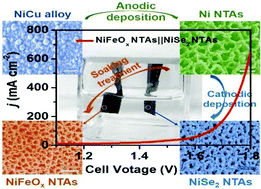Ni nanotube array-based electrodes by electrochemical alloying and de-alloying for efficient water splitting†
Abstract
The design of cost-efficient earth-abundant catalysts with superior performance for the hydrogen evolution reaction (HER) and oxygen evolution reaction (OER) is extremely important for future renewable energy production. Herein, we report a facile strategy for constructing Ni nanotube arrays (NTAs) on a Ni foam (NF) substrate through cathodic deposition of NiCu alloy followed by anodic stripping of metallic Cu. Based on Ni NTAs, the as-prepared NiSe2 NTA electrode by NiSe2 electrodeposition and the NiFeOx NTA electrode by dipping in Fe3+ solution exhibit excellent HER and OER performance in alkaline conditions. In these systems, Ni NTAs act as a binder-free multifunctional inner layer to support the electrocatalysts, offer a large specific surface area and serve as a fast electron transport pathway. Moreover, an alkaline electrolyzer has been constructed using NiFeOx NTAs as the anode and NiSe2 NTAs as the cathode, which only demands a cell voltage of 1.78 V to deliver a water-splitting current density of 500 mA cm−2, and demonstrates remarkable stability during long-term electrolysis. This work provides an attractive method for the design and fabrication of nanotube array-based catalyst electrodes for highly efficient water-splitting.



 Please wait while we load your content...
Please wait while we load your content...